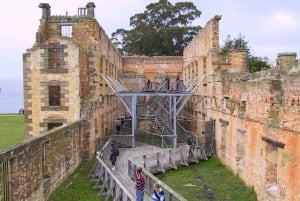Tasmanian Snakes
Tasmania is home to three breeds of snake, the Tiger Snake, Copperhead and White-lipped Whip Snake, all of which are venomous.
The good news for those of a nervous disposition is that snakes are just as wary of you as you are of them. With a little bit of knowledge and care the chances of being bitten by a snake here in Tasmania is very low.
The last person to die from a snake bite in Tasmania was a snake handler in 1977 and the last person in the bush was 1966, so the risks are pretty low. The best thing to do if you spot a snake is to avoid them and let them go their own way. If a snake feels trapped or threatened they will naturally become aggressive and especially during the breeding season, which is late summer.
Precautions
When bushwalking wear good walking boots with gaiters and sturdy trousers.
Caution when stepping over logs as snakes may be basking on the other side.
Avoid walking through reeds or long grass.
Don't try to handle or kill snakes
Avoid snakes when sighted.
Snakes are protected in Tasmania.
Snake Bite
The venom is a complex mixture of protein molecules containing neuro-toxins (nerve poisons). If enough is injected the nerves controlling the heart and lungs are adversely affected and death may result. Once in the body, poison of Tasmanian snakes flows through the lymphatic system (just under the skin), not the blood vessels. A pressure bandage slows the blood flow in the lymphatic systems and allows blood flow through arteries and veins. A tourniquet is not recommended as it cuts off all circulation and can lead to amputation.
The fangs of Tasmanian snakes are not particularly efficient as they only have a groove in them that the poison runs down, so a lot of the poison is lost on the skin's surface or on clothes that the snake may have bitten through. Outside the body, the poison is harmless.
First Aid
One of the early symptoms of Tiger Snake bite is a massive frontal headache.
1. Stay calm! Fear often leads to shock which makes the situation more dangerous. Reassure the victim at all times. Record information on allergies and medications of the patient. There is always a chance of unconsciousness. Record pulse rate.
2. Bandage the bitten area immediately with a broad, firm bandage, preferably elastic based (e.g. a sports bandage), and cover as much of the surrounding area or limb as possible and leave it covered. Bites are usually on a limb so bandage the whole limb starting from the extremity and working up the limb. Do not remove the bandage.
3. Immobilise the bitten area immediately - if the bite is on a limb, secure with a splint.
4. Bring transport to the victim, if possible, for transfer to medical care.
5. Seek medical help.
6. Treat the symptoms, give CPR if necessary.
7. DO NOT cut the bitten area.
8. Snake identification is not necessary as all native Tasmanian snake bites are treated with the same antivenom.
For further information have a look at this fact sheet from All About Reptiles.
Pictures courtesy of Tasmania Department of Primary Industries and Water: Tiger Snake, Copperhead Snake, White-lipped Whip Snake.











